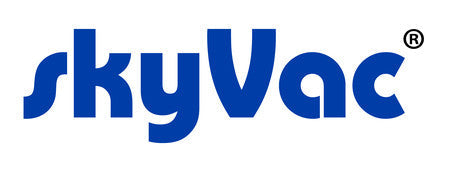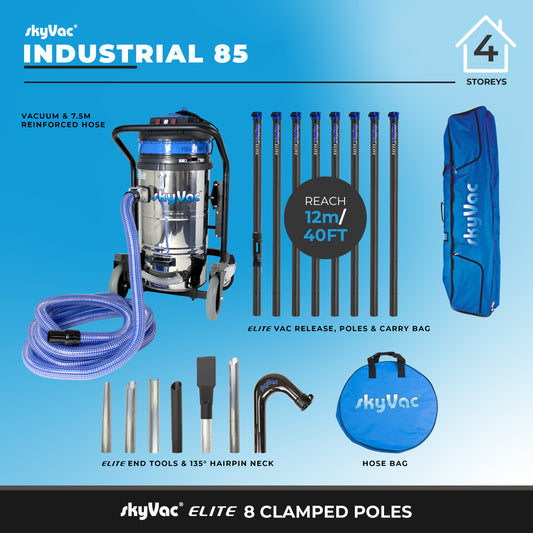Mastering the Art of Long Reach Dusting for a Spotless Home
Share
We all want a clean home, right? But sometimes, dust and grime seem to magically appear in the highest, most out-of-reach spots. Think ceiling fans, tall bookshelves, or the tops of cabinets. Getting to these places can be a real pain, often involving wobbly ladders or awkward stretches. That's where the art of Long Reach Dusting comes in. It's all about having the right tools and knowing how to use them to tackle those dusty high-up areas without all the hassle.
Key Takeaways
- Dust and dander naturally settle in hard-to-reach places, impacting air quality and appearance.
- Using specialized poles and attachments allows for safe and effective Long Reach Dusting from the ground.
- Proper technique and the right equipment, like vacuum systems, make high dusting efficient and dust-free.
Understanding The Need For Long Reach Dusting
We all know that dust seems to magically appear everywhere, but have you ever noticed how much of it seems to gather in the highest, most out-of-reach spots in our homes? It’s not just your imagination. These elevated areas are prime real estate for dust, dander, and all sorts of other tiny particles that float around in the air.
Why Dust and Dander Accumulate In High Places
So, why do these high places become such dust magnets? It really comes down to physics and how air moves. Dust is made up of incredibly fine particles – think dead skin cells, tiny fibers from our clothes, dirt tracked in from outside, and even pollen. Dander, which comes from our pets or even ourselves, is just more of these tiny skin flakes. Because these particles are so light, they get easily kicked up into the air by everyday activities like walking, opening doors, or even just the air circulating from our heating and cooling systems. Warm air naturally rises, carrying these particles with it. Once they’re up there, they just settle down wherever they can, which often means on ceiling beams, the tops of cabinets, light fixtures, vents, and those awkward upper corners of rooms.
The Importance of Addressing Overhead Dust Buildup
Ignoring these high-up dust bunnies isn't just about aesthetics, though a clean ceiling fan does look much better. There are actually some pretty good reasons why we should pay attention to them. For starters, that dust can contain allergens, mold spores, and other things that aren't great for our breathing. When disturbed, these particles can get back into the air we breathe, which can be a real problem for anyone with allergies or asthma. Plus, in some cases, a thick layer of dust around electrical fixtures or vents can actually pose a fire hazard. It might seem like a small thing, but keeping these high areas clean contributes to better air quality and a safer living space overall. It’s about maintaining a truly clean and healthy home environment, from floor to ceiling.
Essential Tools For Effective Long Reach Dusting
When we talk about tackling dust in those hard-to-reach places, having the right gear makes all the difference. It’s not just about having a long pole; it’s about having a system that works efficiently and safely. We've found that the SkyVac range offers some really solid options for this kind of work.
Choosing The Right Poles And Attachments
First off, let's talk poles. We need something that's lightweight but sturdy enough to handle the job. Carbon fiber poles are usually our go-to because they're incredibly light, which means less fatigue when you're working overhead for extended periods. They also offer great rigidity, giving us better control.
- Telescopic Poles: These are fantastic for quick adjustments. You can extend them to the exact height you need and lock them securely. They're super convenient for varying ceiling heights or reaching different spots.
- Clamped Poles: These often come in sections that you connect. They can be really robust and are great for heavier-duty attachments or when you need maximum stability at full extension.
Beyond the poles themselves, the attachments are key. We use a variety of brushes and heads depending on the surface:
- Dusting Brushes: Look for ones with static-dissipating bristles to help grab and hold onto dust. Different shapes and angles are helpful for corners, pipes, and beams.
- Microfiber Sleeves: These are great for more delicate surfaces or when you want to trap dust effectively. They're usually washable, which is a big plus.
- Specialized Heads: For things like ductwork or intricate light fixtures, you'll want angled or flexible heads that can get into tight spots.
Vacuum Systems For Dust-Free Long Reach Dusting
While dry dusting with brushes is effective, for a truly spotless finish and to manage airborne dust, a vacuum system is the way to go. This is where SkyVac's high-reach vacuum systems really shine.
These systems are designed to connect directly to your poles, allowing you to suck up dust and debris right as you dislodge it. This prevents dust from falling onto surfaces below or becoming airborne, which is a huge benefit for air quality and cleanliness.
Using a vacuum system with your long-reach poles means you're not just moving dust around; you're actually removing it from the environment. This is particularly important in places where dust can be a health concern or a fire hazard.
When choosing a vacuum system, consider:
- Power and Airflow: Make sure the vacuum has enough power (measured in CFM – cubic feet per minute) to effectively pull dust up the pole and into the collection unit.
- Filtration: For the best results, especially in sensitive environments, look for systems with HEPA filters. This traps the finest particles, preventing them from being recirculated.
- Portability: If you move between different locations, a system that's easy to transport, like the SkyVac 30 or 78, is a big advantage. Some units have built-in trolleys, making them mobile.
By combining the right poles and attachments with a powerful vacuum system, we can tackle even the most challenging high-dusting jobs efficiently and safely, all from ground level.
Mastering The Technique Of Long Reach Dusting
Now that we've covered the tools, let's talk about how to actually use them effectively. Getting the hang of long-reach dusting might seem straightforward, but there are some tricks to make sure you're cleaning thoroughly and safely. We want to make sure we're not just moving dust around, but actually removing it.
Step-By-Step Guide To High Dusting
Here’s a simple process we can follow to tackle those high-up dust bunnies:
- Assess the Area: Before you start, take a look at what you need to clean. Are you dealing with light cobwebs, thick dust on beams, or dust in vents? This will help you pick the right attachment for your pole.
- Assemble Your Pole and Attachment: Connect your chosen brush or vacuum head to the extension pole. Make sure it's securely fastened. If you're using a vacuum system like the SkyVac, connect the hose to the pole and the vacuum unit.
- Work Top-Down: Always start from the highest point and work your way down. This way, any dust that gets dislodged will fall onto an area you haven't cleaned yet, rather than onto a freshly dusted surface.
- Gentle but Firm Strokes: For dry dusting with a brush, use smooth, sweeping motions. Don't scrub too hard, especially on delicate surfaces. If you're using a vacuum attachment, ensure good contact with the surface to capture the dust effectively.
- Reach into Corners and Crevices: Use angled attachments or flexible tools to get into tight spots, like around light fixtures or ductwork.
- Check Your Work: Periodically look up to see if you've missed any spots. Some poles have camera attachments that can be really helpful for a closer inspection.
- Clean Your Tools: Once you're done, clean your brushes or vacuum heads. If you used microfiber sleeves, wash them. This keeps your tools in good shape for the next job.
Best Practices For Safe And Efficient Cleaning
To make sure our high dusting efforts are both safe and effective, we should keep a few things in mind:
- Safety First: Always be aware of your surroundings. Make sure you have a stable stance and aren't overextending yourself. If you're working in a busy area, consider doing it during off-hours.
- Use the Right Tools: We've talked about poles and attachments. Using the correct ones for the job makes a huge difference. For instance, a stiff brush might be great for beams, but a softer one is better for light fixtures.
- Vacuuming is Key: Whenever possible, use a vacuum system like the SkyVac. This captures the dust right as you remove it, preventing it from becoming airborne and settling elsewhere. It's much cleaner than just brushing dust around.
- Regular Maintenance: Keep your poles and attachments clean and in good repair. Check for any damage before each use. This ensures they work correctly and safely.
Proper technique isn't just about getting the dust off; it's about doing it in a way that doesn't create more work or hazards. Thinking about how the dust will move and how to contain it makes all the difference. We want to leave the space cleaner than we found it, without making a mess in the process. This means being methodical and using the right equipment for the job at hand. It’s about working smarter, not harder.
Want to reach those tricky high spots without a ladder? Mastering the technique of long reach dusting is key to a cleaner space. Our tools make it easy to tackle dust in those hard-to-get areas. Visit our website today to find the perfect long reach dusting solution for your needs!
Wrapping Up Our High Dusting Journey
So, there you have it! We've covered why dust loves to hang out in those hard-to-reach spots and how to tackle it effectively. Using the right tools, like those long poles and specialized attachments from brands like SkyVac, makes all the difference. It's not just about making things look clean; it's about improving the air we breathe and keeping our spaces safer. We hope this guide helps you feel more confident in keeping every corner of your home or workspace spotless. Happy dusting!
Frequently Asked Questions
Why do we need to dust high places?
Dust and tiny bits of skin, called dander, float around in the air. Because they're so light, they naturally drift upwards and settle on things like ceiling beams, light fixtures, and tops of cabinets. If we don't clean these spots, this dust can make the air quality worse and even cause problems for people with allergies or breathing issues. Plus, a dusty place just doesn't look very clean!
What kind of tools help us reach high spots for dusting?
We use special tools with long poles that can extend quite far, sometimes up to 40 feet! These poles can attach to different cleaning heads, like brushes or vacuums. Some brushes are designed to grab dust, while vacuum attachments suck it right up, which is great for keeping dust from spreading everywhere. It means we can clean safely from the ground without needing ladders.
How can we make sure dusting high places is safe and effective?
Safety is super important when cleaning up high. We always try to do our dusting from the ground using our long poles, so we don't have to climb. We also make sure to use the right attachments for the job, like vacuum heads that capture dust instead of just moving it around. Working from the top down is also key, so we don't make a mess of areas we've already cleaned.








